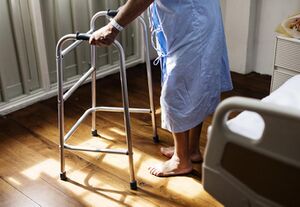Yubi Wakka Finger Ring Test: Difference between revisions
Candace Goh (talk | contribs) No edit summary |
Kim Jackson (talk | contribs) m (Kim Jackson moved page "Yubi-wakka" (Finger-Ring) Test to Yubi Wakka Finger Ring Test: Text replacement - ""Yubi-wakka" (Finger-Ring) Test" to "Yubi Wakka Finger Ring Test") |
||
| (5 intermediate revisions by 2 users not shown) | |||
| Line 2: | Line 2: | ||
'''Top Contributors''' - {{Special:Contributors/{{FULLPAGENAME}}}}</div> | '''Top Contributors''' - {{Special:Contributors/{{FULLPAGENAME}}}}</div> | ||
== Purpose == | == Purpose == | ||
[[File:A-patient-holding-a-walking-frame.jpg|thumb|Frail individual]] | |||
The“Yubi-wakka" (finger-ring) test is a simple self-screening tool developed by the Japanese to check for [[sarcopenia]] among community-dwelling older adults.<ref>Tanaka T, Takahashi K, Akishita M, Tsuji T, Iijima K. “Yubi‐wakka”(finger‐ring) test: A practical self‐screening method for sarcopenia, and a predictor of disability and mortality among Japanese community‐dwelling older adults. Geriatrics & gerontology international. 2018 Feb;18(2):224-32.</ref> | The“Yubi-wakka" (finger-ring) test is a simple self-screening tool developed by the Japanese to check for [[sarcopenia]] among community-dwelling older adults.<ref name=":0">Tanaka T, Takahashi K, Akishita M, Tsuji T, Iijima K. [https://onlinelibrary.wiley.com/doi/10.1111/ggi.13163 “Yubi‐wakka”(finger‐ring) test: A practical self‐screening method for sarcopenia, and a predictor of disability and mortality among Japanese community‐dwelling older adults.] Geriatrics & gerontology international. 2018 Feb;18(2):224-32.</ref> | ||
== Technique == | |||
Conduct self-test in a seated position, no instrument required. | |||
# Make a ring with the index fingers and thumbs of both hands | |||
# Gently circle the thickest part of the non-dominant calf of the leg which is bent at a 90° angle | |||
# Check whether or not the non-dominant calf circumference is“bigger,”“just fits”or“smaller” as compared with the finger-ring circumference. | |||
== Evidence == | == Evidence == | ||
The "Yubi-wakka" assessment represents a highly useful approach for pinpointing older individuals who are vulnerable to sarcopenia, disability, and the risk of mortality. | |||
* This test has the potential to enhance proactive measures in preventing sarcopenia by acting as an early warning for older adults to guard against developing this condition.<ref name=":0" /><ref>Fujii H, Kodani E, Kaneko T, Nakamura H, Sasabe H, Tamura Y. [https://www.ncbi.nlm.nih.gov/pmc/articles/PMC6731048/ “Yubi-wakka”(finger-ring) test: a tool to detect prefrailty in elderly populations, a pilot study.] Journal of Clinical Medicine Research. 2019 Sep;11(9):623.</ref> | |||
* Given the generally robust health and longevity of the Japanese population, addressing sarcopenia becomes particularly crucial, particularly for individuals aged over 75 years. | |||
* The existence of [[Metabolic Syndrome|metabolic syndrome]], as identified through the Yubi-wakka test, might constitute a potential risk factor for sarcopenia and subsequent [[Introduction to Frailty|frailty]]. This warrants heightened vigilance, particularly in the case of women<ref>Fujii H, Kodani E, Kaneko T, Nakamura H, Sasabe H, Tamura Y. [https://www.ncbi.nlm.nih.gov/pmc/articles/PMC9806034/ Sarcopenia and coexistent risk factors detected using the ‘Yubi-wakka’(finger-ring) test in adults aged over 65 years in the public annual health check-up in Tama City, Tokyo: a cross-sectional study.] BMJ open. 2022 Dec 1;12(12):e061613.</ref>. | |||
== Resources == | == Resources == | ||
* [https://bmcpublichealth.biomedcentral.com/articles/10.1186/s12889-021-10844-3 Factors associated with sarcopenia screened by finger-circle test among middle-aged and older adults: a population-based multisite cross-sectional survey in Japan] | |||
* [https://www.sciencedirect.com/science/article/abs/pii/S0197457222002877?via%3Dihub Comparison of four screening methods for sarcopenia among community-dwelling older adults: A diagnostic accuracy study.] | |||
== References == | == References == | ||
<references /> <div class="noeditbox"> | <references /> <div class="noeditbox"></div> | ||
[[Category:Older People/Geriatrics]] | |||
[[Category:Objective Assessment]] | |||
Latest revision as of 12:59, 20 November 2023
Purpose[edit | edit source]
The“Yubi-wakka" (finger-ring) test is a simple self-screening tool developed by the Japanese to check for sarcopenia among community-dwelling older adults.[1]
Technique[edit | edit source]
Conduct self-test in a seated position, no instrument required.
- Make a ring with the index fingers and thumbs of both hands
- Gently circle the thickest part of the non-dominant calf of the leg which is bent at a 90° angle
- Check whether or not the non-dominant calf circumference is“bigger,”“just fits”or“smaller” as compared with the finger-ring circumference.
Evidence[edit | edit source]
The "Yubi-wakka" assessment represents a highly useful approach for pinpointing older individuals who are vulnerable to sarcopenia, disability, and the risk of mortality.
- This test has the potential to enhance proactive measures in preventing sarcopenia by acting as an early warning for older adults to guard against developing this condition.[1][2]
- Given the generally robust health and longevity of the Japanese population, addressing sarcopenia becomes particularly crucial, particularly for individuals aged over 75 years.
- The existence of metabolic syndrome, as identified through the Yubi-wakka test, might constitute a potential risk factor for sarcopenia and subsequent frailty. This warrants heightened vigilance, particularly in the case of women[3].
Resources[edit | edit source]
- Factors associated with sarcopenia screened by finger-circle test among middle-aged and older adults: a population-based multisite cross-sectional survey in Japan
- Comparison of four screening methods for sarcopenia among community-dwelling older adults: A diagnostic accuracy study.
References[edit | edit source]
- ↑ 1.0 1.1 Tanaka T, Takahashi K, Akishita M, Tsuji T, Iijima K. “Yubi‐wakka”(finger‐ring) test: A practical self‐screening method for sarcopenia, and a predictor of disability and mortality among Japanese community‐dwelling older adults. Geriatrics & gerontology international. 2018 Feb;18(2):224-32.
- ↑ Fujii H, Kodani E, Kaneko T, Nakamura H, Sasabe H, Tamura Y. “Yubi-wakka”(finger-ring) test: a tool to detect prefrailty in elderly populations, a pilot study. Journal of Clinical Medicine Research. 2019 Sep;11(9):623.
- ↑ Fujii H, Kodani E, Kaneko T, Nakamura H, Sasabe H, Tamura Y. Sarcopenia and coexistent risk factors detected using the ‘Yubi-wakka’(finger-ring) test in adults aged over 65 years in the public annual health check-up in Tama City, Tokyo: a cross-sectional study. BMJ open. 2022 Dec 1;12(12):e061613.







